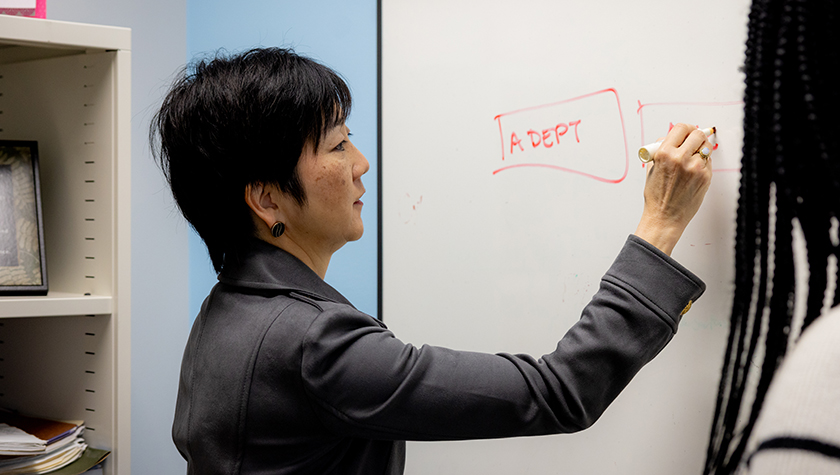
A new study by UW–Madison School of Pharmacy researchers reveals the hurdles and unsung efforts of Wisconsin pharmacists during the COVID-19 Test-to-Treat rollout
By Jennifer LW Fink
As pharmacists stepped into expanded clinical roles during the COVID-19 pandemic — including prescribing Paxlovid through the federal Test-to-Treat program — their ability to help patients often depended on system-level support.
A new study from the University of Wisconsin–Madison School of Pharmacy, led by Health Services Research in Pharmacy doctoral student Sura AlMahasis, explores the experiences of Wisconsin pharmacists who prescribed Paxlovid.
The findings, published in the Journal of the American Pharmacists Association, reveal key facilitators and barriers — such as access to electronic health records, collaborative provider relationships, and reimbursement structures — that shaped their ability to deliver timely, effective care.
“We wanted to learn what went well for pharmacists — what helped them deliver the service — and also what barriers they encountered,” says AlMahasis.
Prescribing in practice
The COVID-19 pandemic presented unexpected opportunities to study how pharmacists impact the health of communities. In March 2022, the federal government introduced the Test-to-Treat program, which allowed patients to be assessed by a healthcare provider and, if appropriate, be prescribed COVID-19 therapeutics, like Paxlovid, and fill their prescriptions all at the same site. Because Paxlovid must be taken within the first five days of symptoms to be effective, expedited assessment and treatment is key to improving patient outcomes.
In July 2022, the U.S. Food and Drug Administration (FDA) brought pharmacists under the Test-to-Treat umbrella, authorizing them to prescribe Paxlovid to appropriate patients.
“The Test-to-Treat program came to expand access to [Paxlovid], and because pharmacies are highly accessible, they are ideal venues to facilitate timely and equitable access to this medication.”
—Sura AlMahasis
“The Test-to-Treat program came to expand access to this medication, and because pharmacies are highly accessible, they are ideal venues to facilitate timely and equitable access to this medication,” says AlMahasis.
Under the mentorship of Associate Professor Jay Ford and Professor Dave Mott, both of the School’s Social and Administrative Sciences Division, AlMahasis sought to understand pharmacists’ experiences with the national program.
AlMahasis conducted semi-structured interviews with five pharmacists in Wisconsin to better understand what helped or hindered their prescribing of Paxlovid. Three worked in leadership roles (two pharmacy managers and a pharmacist-in-training), one represented a pharmacy partnering with two health systems, and one represented a healthcare system collaborating with 15 independent pharmacies.

Access to electronic health records (EHR) was a key facilitator and barrier, depending on whether pharmacists had access. Those with EHR access, and therefore patient health information, could prescribe and dispense Paxlovid far more efficiently — and with less stress — than those without that capability.
To prescribe Paxlovid, pharmacists must perform a clinical assessment of each patient, one that goes beyond a simple COVID-19 test. Prescribing pharmacists must also conduct a review of patients’ medications and lab values.
“It’s relatively easy for most pharmacists to review patients’ medication in order to check for any potential interactions,” says AlMahasis, a pharmacist who earned her Doctor of Pharmacy degree in Jordan, her home country, before moving to the United States to pursue research. “They can either ask the patient to report what medications they’re on or, if they’re a regular pharmacy patient, they can look in pharmacy software.”
Checking labs to determine if the patient’s kidney and liver function is healthy enough to safely take Paxlovid is more challenging.
“The pharmacist needs to review patient labs from the past 12 months,” AlMahasis says. “This is not an easy thing that a patient can self-report.”
Pharmacists who had access to EHRs via their pharmacy’s relationship with a health system were able to complete their reviews of patient labs quickly and easily — often, in less than five minutes. But community pharmacists unaffiliated with a health system had to make phone calls to provider offices.
Pharmacists reported that the process often involved repeated calls and “pushback from nurses who were unaware of the Paxlovid prescribing process.” At times, pharmacists were unable to prescribe Paxlovid to people who may have otherwise been eligible.
Collaborative work relationships with other healthcare providers were a facilitator that helped certain pharmacists function effectively despite a lack of access to EHRs.
“Pharmacists are very willing and able to play an active and integral role in public health, and specifically in times of crisis or pandemic.”
—Sura AlMahasis
“Some of the pharmacists I interviewed mentioned that if they wanted to verify that patient X didn’t have kidney disease, they could just call Dr. X because they knew them,” AlMahasis says. “Good external relationships with healthcare providers supported this kind of collaborative care.”
Digital support tools, including checklists shared by the Centers for Disease Control, the Wisconsin Department of Health Services, and the American Pharmacists Association, were also helpful.
“Pharmacists told us these tools streamlined the screening and prescribing process,” AlMahasis says.
Valuable but undervalued
Interviewed pharmacists also cited the ability to conduct remote screenings and patient counseling — typically, either by phone or at a drive-up window — as a facilitator of the Test-to-Treat program. These practices allowed pharmacists to effectively deliver care while protecting the health and well-being of pharmacy patients and staff.
Inadequate reimbursement was a significant barrier with the potential to jeopardize pharmacists’ future participation in expanded practice opportunities. Pharmacists interviewed for the study described the available compensation as “unfair,” “not very good,” and “ridiculous.”

“Reimbursement is very, very low,” AlMahasis says. “It’s nothing compared to the amount of work they do and the clinical expertise they put into the process. They gave pharmacists the green light to do this, but they were not as supported as they should have been.”
Yet the pharmacists interviewed expressed largely positive sentiments about their experiences.
“Pharmacists are very willing and able to play an active and integral role in public health, and specifically in times of crisis or pandemic,” AlMahasis says. “They are doing this work because they feel a sense of responsibility and feel it’s an extension of their profession.”
AlMahasis says she hopes her study emphasizes the need for policy change.
“To improve patient outcomes and access to healthcare, pharmacists need to be granted full access to the EHR,” she says. “Pharmacists also need full federal provider status recognition, which will improve reimbursement and incentivize pharmacists’ clinical efforts.”

